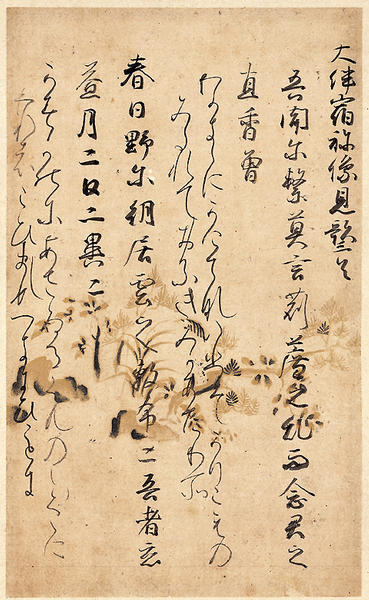桂本万葉集巻第四断簡(栂尾切)
- 平安時代
- 11c
- 彩箋墨書
- H-21 W-12.6
- 所蔵
- 伏見天皇→前田利家夫人松子(芳春院)→桂宮家
平安時代後期 11世紀
彩箋墨書
縦:21.0cm 横:12.6cm
桂宮家に伝来したことからこの名で呼ばれる。もとは巻子本。宮内庁には同じ巻第四の残巻が保管されているが,料紙は白,黄,茶,赤といったさまざまな染紙が用いられ,下絵には樹木,草花,蝶などが描かれる。また,紙背の継ぎ目には伏見天皇が花押を据えており,かつて同天皇の愛蔵品であったことが知られる。
ちなみに,のち加賀の前田利家夫人松子(芳春院)の所蔵となり,その孫の富子が智仁親王のもとに嫁ぐにあたり桂宮家に移った。元暦校本,藍紙本,金沢本,天治本とともに五大万葉集の一つに数えられる。「栂尾切」の呼称の起こりは不詳。
歌題を少し高く書き,歌は真名と仮名の二つの書体を並記する。かつては伝承筆者として,紀貫之,源順,宗尊親王などの名があがっていたが,現在は「高野切(第二種)」「関戸本和漢朗詠集切」と筆跡を同じくすることから,源兼行(生没年不詳)をもってその筆者にあてる説が有力となっている。 (下坂)
和歌
平安時代から鎌倉時代初期にかけての和歌などのかなの書は古筆(こひつ)と呼ばれます。本来は古人の筆跡を意味する言葉でしたが、いつの頃からかそう呼ばれるようになりました。王朝文化の精華ともいうべき古筆は、茶席の一幅として、国文学の文献として、そして学書の規範として、非常に価値の高いものといえます。
文保百首断簡(伝亀山天皇筆)
元暦校本万葉集
天治本万葉集巻第十断簡(仁和寺切)
続古今和歌集断簡(六帖切)(伝藤原行成筆)
麗花集断簡(香紙切)(藤原公任筆)
詠草(藤原定家筆) 五月雨
春日懐紙(中臣祐方筆)
新古今和歌集断簡(伏見天皇筆)
源 兼行(みなもとのかねゆき)
平安時代中期の能書家。藤原道長(ふじわらのみちなが)建立の法成寺(ほうじょうじ)・金堂と阿弥陀堂(あみだどう)(無量寿院)(むりょうじゅいん)の扉絵の色紙形を書いたとされています。当時第一の手書きとされ、藤原頼通(ふじわらのよりみち)に用いられ、平等院鳳凰堂の色紙形も書いたといわていますが、歌人ではなかったため古筆の筆者としては尊重されませんでした。
読み書き下し
大伴宿袮像見歌三首
吾聞尓 繋莫言 苅薦之 乱而念 君之
直香曽
わかきゝに かけてないひそ かりこもの
みたれておもふ きみかたたかそ
春日野尓 朝居雲之 敷布二 吾者恋
益 月二日二異二
かすかのに あさゐるくもの しくへに
あはこひまさる つきにひにけに
Catalogue Entry
Fragment of Scroll 4 (known as Toga-no-o-gire)
Late Heian period, 11th century
Hanging scroll, ink on decorated paper
Height, 21.0cm; width, 12.6cm
The name for this version of the Man'yoshu derives from the fact that this version was traditionally held by the Prince of Katsuranomiya. Originally this version was mounted as a kansubon scroll. The remainder of this 4th scroll is now in the collections of the Agency for Cultural Affairs and reveals that a variety of papers were used for the scroll, including white, yellow, brown, and red, and that the underdrawings include images of trees, flowers and plants, and butterflies. The kao (written seal) of Emperor Fushimi appears on the seam on the back of the paper, and this indicates that it was a beloved possession of that emperor.
This scroll was also later in the collection of Matsuko (Hoshun'in), the wife of Maeda Toshiie of Kaga, and when her grandchild Tomiko became the bride of the Imperial Prince Toshihito, this work was transferred to the Katsu-ranomiya family. This version numbers among the Five Great Versions of the Man'yoshu, along with the Genryaku Kohon, Aigami, Kanazawa, and Tenji versions. The origins of the Toga-no-o-gire name are not known.
The titles of the poems are written slightly above the rest of the text, and the poems are written out in both full Chinese characters and in kana forms. The elegant flowing script has been traditionally ascribed to such famous calligraphers as Ki-no-Tsurayuki, Minamoto-no-Shitago, and the Imperial Prince Munetaka. Among extant texts, the same hand has been found in the Koyagire (second type), Sekido version of the Wakanroeishugire, and this resemblance supports the argument that the present fragment was written by Minamoto-no-Kaneyuki (dates unknown). MS
読み下し
大伴宿祢像見歌三首
吾聞尓 繋莫言 苅薦之 乱而念 君之
直香曽
わかきゝに かけてないひそ かりこもの
みたれておもふ きみかたたかそ
春日野尓 朝居雲之 敷布二 吾者恋
益 月二日二異二
かすかのに あさゐるくもの しくへに
あはこひまさる つきにひにけに
